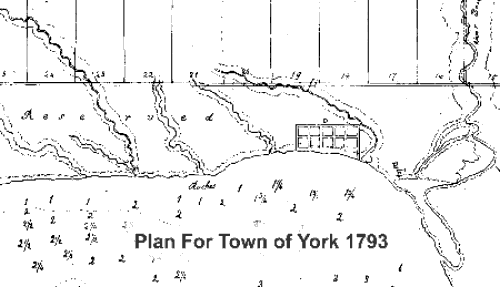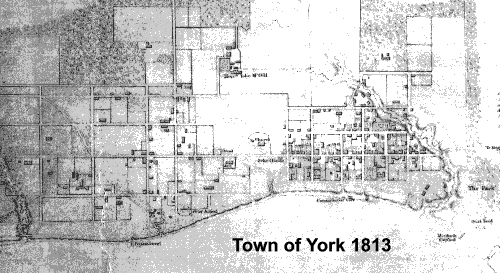
Incorporate as The City of Toronto in 1834.
The Village or Town of York is the oldest part of Toronto. It was laid out on orders of Col. John Graves Simcoe, first Lieutenant Governor of Upper Canada, in 1793. The streets and blocks are still there; square blocks along King Street, between Jarvis and Berkeley Streets and between Adelaide and Front Streets. King, George, Frederick, and Princess Streets still have their old names. Because of the clay soil and little or no maintenance, these street were frequently in poor shape and the town got the nickname of Muddy York. This is now a downtown area with much history, and interesting developments. The site of the second and third parliament buildings in Upper Canada can be found as well as early schools.

During Col. Simcoe’s incumbency, York continued to grow. He placed his “loyal monarchical” stamp on it through the names he gave the streets. Dr. Scadding tells us in “Toronto, Past and Present: Historical and Descriptive,” page 19. that “The town-plot, as defined at this time, was a compact little parallelogram, bounded on the west by George Street, on the east by Ontario Street, on the north by Duchess Street (now Richmond), and on the south by Palace Street (now Front) Streets that still retain their original names (in his day). The loyal monarchical character of the Governor appears in nearly every one of these street names, as also in the names given to other streets, as well as in the name of the town itself. The main thoroughfare was King Street ; the next street parallel to it on the north was Duke Street (now Adelaide); the street north of that Duchess Street (now Richmond). The boundary westward was George Street ; the next street parallel to that eastward was Frederick Street, and the street following that was Caroline Street (now Sherbourne), while the one succeeding that was Princes Street (now Princess}. The last street running north and south was Ontario Street. George Street bore the name of George, Prince of Wales, afterwards George IV. Caroline Street commemorated his wife, the unfortunate Caroline of Brunswick. Duke Street alluded to the Duke of York, Duchess Street to his wife, and Frederick Street was distinguished by his Christian name. The general name, Princes Street, was a comprehensive compliment to the other royal princes, without specifying them. Ontario Street indicated the track which, doubtless from time immemorial, led down to the canoe-landing nearest to the ‘carrying- place’ on the Island, where the small craft passing up and down the lake and trading at York, were wont to be lifted across the narrow neck of land there. Palace Street was so styled because it was expected to be the via sacra to the ‘ Palace of Government,’ to speak in French style; i.e., the public buildings for parliamentary and other purposes, to which, in fact, it did lead, down to in 1824.”

By 1813 York had grown to be a small town and had many houses shops and government buildings including the provincial Parliament. Most development was still in the original town plot, but there were scattered houses west to Russell Creek and some north of Lot Street, now Queen Street.

In 1834, York had grown to be a town of 10,000 and was incorporated as the City of Toronto. It now had a proper civic government and William Lyon Mackenzie was elected as its first mayor. There were five wards: St. Patrick’s, St. Andrew’s, St. George’s St.David’s and St Lawrence; each had a Councillor and an Alderman. Settlement was spreading north of Queen Street, west to the Fort and east to the Don River.
For thousands of years, before Governor Simcoe established the Town of York, the First Nations had use this area for fishing trading and socializing. It was a great place to visit in the spring and the fall.

